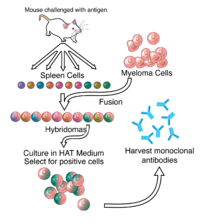
Photo from wikipedia
Since the inception of antibodies as magic bullets for targeting antigens with high specificity for various in vitro and in-vivo detection and therapy applications, the field has evolved and remarkable… Click to show full abstract
Since the inception of antibodies as magic bullets for targeting antigens with high specificity for various in vitro and in-vivo detection and therapy applications, the field has evolved and remarkable success has been achieved not only in the methods of development of these targeting agents but also in their applications. The utilization of these moieties for the development of antibody-based radiopharmaceuticals for diagnostic and therapy (Theranostic) purposes has resulted in the availability of various cancer-targeting agents suitable for clinical applications. The high affinity and specificity of antibodies towards the target antigens overexpressed on tumors render them an excellent carrier molecule for radionuclide delivery. Although intact antibodies have high potential as imaging and therapeutic agents, a major drawback of intact antibody-based radionuclide targeting is their slow pharmacokinetics and poor penetration into solid tumors. In contrast to large intact antibodies, engineered antibody fragments such as minibodies, diabodies, single-chain variable region fragments (scFvs), nanobodies, and non-antibody protein scaffolds-based moieties retain the specificities and affinities of intact antibodies in addition to improved pharmacokinetics for imaging and therapy of solid tumors. These engineered carrier molecules are not only amenable for simple and robust radiolabeling procedures but also provide high contrast images with minimal radiotoxicity to vital organs. However, in various instances, rapid clearance with sub-optimal tumor accumulation, limiting renal dose, and cross-reactivity of these radiolabeled engineered smaller molecules was also observed. Herein, we review current knowledge of the recent methods for the development of antibody-based targeting moieties, the suitability of various engineered formats for targeting tumors, and radiolabeling strategies for the development of radio formulations. We discuss promising antibody-based and non-antibody-based affibody radiopharmaceuticals reported for clinical applications. Finally, we highlight how emerging technologies in antibody engineering and drug development can be amalgamated for designing novel strategies for cancer imaging and therapy.
Journal Title: Current medicinal chemistry
Year Published: 2022
Link to full text (if available)
Share on Social Media: Sign Up to like & get
recommendations!